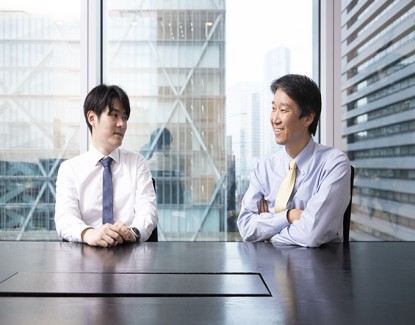Laying the Foundation: Japanese Homebuilders in the Growing U.S. Market
Japanese homebuilders have been expanding into the overseas housing markets, particularly in the U.S. With their manufacturing excellence and high-quality homes, we believe these homebuilders could grow significantly over the long term.
-
 Masakazu Takeda, CFA, CMAPortfolio Manager
Masakazu Takeda, CFA, CMAPortfolio Manager -
 Angus Lee, CFAPortfolio Manager
Angus Lee, CFAPortfolio Manager
Key Takeaways
» We believe the U.S. housing market holds tremendous growth potential.
» At least 1.2 million new single-family homes need to be supplied annually in the U.S.
» Japanese homebuilders can leverage their manufacturing excellence to deliver high-quality homes to the U.S. consumer.
» We believe three major Japanese homebuilders—Sekisui House, Sumitomo Forestry, and Daiwa House—could grow significantly over the long term.
» Japanese homebuilders look attractively priced and have a higher return on equity and solid dividends.
The Growing U.S. Single-Family Housing Market
In contrast to Japan, where population decline poses long-term challenges, the growth potential of the U.S. housing market is vast. There are 130 million households, which have been increasing by about 1.2 million annually for many years, driven by:
• Natural population growth and immigration
• The rise in number of nuclear families
• The longevity of the elderly population
• Younger generations, hesitant during the COVID-19 pandemic, now purchasing their first homes
Despite this trend of market expansion, the supply of new homes in the U.S. has been insufficient for many years since the 2008 subprime mortgage crisis. Several factors contribute to this issue, including strict land zoning regulations, a shortage of construction workers, rising building costs, and the cautious stance of homebuilders who have been limiting supply since suffering severe losses during the financial crisis.
Until around the year 2000, the U.S. housing market was in equilibrium in terms of supply and demand as well as housing stock. However, the introduction of subprime loans and speculative buying led to the formation of a housing bubble, causing a sharp rise in home prices. In response, the supply of new homes surged significantly. From 2002 to 2006, the number of new single-family housing starts ranged between 1.4 million and 1.7 million homes annually, far exceeding the average annual household growth rate of 1.2 million. This resulted in a market oversupply.

When the bubble burst in 2008, the housing industry faced a buildup of inventory and a significant decline in single-family home prices. The annual average of new single-family housing started fell sharply to just 700,000 homes between 2008 and 2020. Meanwhile, the number of households has continued to grow. As a result, the recovery in the supply-demand balance for single-family homes after the bubble burst has been surpassed, leading to a cumulative shortage of approximately 3.7 million new single-family homes as of Q3 2024.1
To close this gap, it is estimated that at least 1.2 million new single-family homes need to be supplied annually.
This figure reflects the consistent increase in household numbers and the replacement of aging single-family homes built between the 1950s and 1970s, which are being replaced at an average rate of about 200,000 units per year.2 Given these factors, the long-term outlook for the new single-family housing market is highly favorable.
Fewer U.S. Homebuilders Opens the Door for Japanese Companies
In the 1990s, the U.S. single-family housing market was highly fragmented, with a large number of players. However, the 2008 subprime mortgage crisis forced many companies into bankruptcy, leading to mergers and acquisitions within the industry. The number of homebuilding businesses decreased by 30%, from 26,000 in 2002 to 17,000 in 2017.3
Though the local aspect of the homebuilding industry persists, larger players that have grown through mergers and acquisitions (M&A) enjoy competitive advantages in several areas:
• raw material procurement
• access to capital
• land acquisition capabilities
• administrative processes such as obtaining building permits
Their market share has gradually increased nationwide. In the early 1990s, the top 10 U.S. homebuilders collectively held less than 10% of the market. By 2023, this figure had risen to 42%, (and 69% by the top 20) reflecting steady industry consolidation.4
While historically Japanese companies had little to no presence in the U.S. market, selective acquisitions and investments in recent years have changed this dynamic. In 2024, U.S. subsidiaries of Sekisui House collectively ranked 5th nationwide in the number of homes sold, while Sumitomo Forestry’s subsidiaries have entered the top 10. Daiwa House, too, has positioned itself within the top 20. An interesting observation is that Japanese homebuilders are the only foreign players actively competing in this market, highlighting their bold expansion strategies.
Japanese Homebuilders Advancing in the U.S. Market
We believe Japanese homebuilders will steadily increase their presence in the U.S. housing market over the long term and gain market share, focusing on the following areas:
1. Leveraging Manufacturing Excellence
Japanese firms excel in industrialized construction techniques, such as prefabrication and the pre-cut construction method. This approach reduces lead times and costs at the construction site and could improve efficiency in the U.S., where labor shortages and rising construction costs are major challenges. Their expertise in the streamlining of construction work, improvement in logistics efficiency, and promotion of joint purchasing can potentially lead to an expansion of market share.
• Sumitomo Forestry is expanding its Fully Integrated Turnkey Provider (FITP) project, which integrates structural panel production with framing work, streamlining the construction process. The number of its U.S. manufacturing factories is expected to increase from nine as of 2024 to 15 or more by 2027.
• Daiwa House is working on cost reduction through joint purchasing from suppliers and promoting industrialization to shorten construction periods. The company’s major subsidiary, Stanley Martin (ranked 22nd in the U.S. in 2024), has seen its sales more than triple since joining the Daiwa House group in 2017 and has shortened construction lead times by about 30% compared to four years ago.
• Sekisui House is leveraging its 2022 acquisition of MDC to improve material and construction cost efficiencies across overlapping markets serviced by its three U.S. subsidiaries.
2. Delivering High-Quality Homes
Many U.S. builders tend to gravitate towards land speculation, whereby they focus primarily on acquiring land with potential for value appreciation, as the dominant business model. In contrast, Japanese manufacturers, operating in a market impacted by population decline, have honed their ability to differentiate their homes through innovative designs and superior construction quality.
Japanese manufacturers excel in building airtight, well-insulated, compact single-family homes with efficient storage solutions. Japanese houses, known for their durability and fire resistance, are also well-suited to areas prone to natural disasters such as hurricanes, tornadoes, and wildfires.
There is potential for the Japanese post-and-beam construction method to gain traction in the U.S. market. The dominant construction style for single-family homes in the U.S. has long been the 2x4 method. This approach, which facilitates the standardization of building materials, involves attaching four wall panels to two ceiling and floor panels. However, the standardization has led to a prevalence of uniform home designs. Moreover, the 2x4 method has certain limitations. Since the structure is supported by wall panels, it is difficult to create large window openings, and the layout flexibility is restricted. In contrast, the Japanese post-and-beam construction method uses pillars and beams to support the structure, allowing for more layout flexibility and the inclusion of large openings such as expansive windows.
The 2x4 process often delays the installation of ceilings and roofs, leaving homes exposed to adverse weather during the building phase. On the contrary, under the Japanese post-and-beam method, ceilings and roofs are typically installed earlier in the process, reducing the risk of weather-related damage during construction.
For example, Sekisui House’s “SHAWOOD” brand, which employs proprietary construction techniques, targets the premium housing market, emphasizing durability and comfort. Aimed at affluent consumers, it features superior housing know-how as well as energy-efficient designs. Their marketing efforts, which position it as ZEH (Net Zero Energy House), highlight reduced utility costs, making the homes also attractive to energy cost-conscious buyers.
Finally, U.S. builders often fall short in terms of after-sales service and warranty coverage. Japanese firms could differentiate themselves by offering comprehensive aftercare and long-term guarantees, drawing on their extensive experience in Japan.
Historical Precedence of Successfully Penetrating the U.S. Market
One historical example of Japanese manufacturers successfully penetrating the U.S. market is the automotive industry during the 1970s and 1980s. At the time, the oil crisis and stricter emissions regulations led to increased demand for fuel-efficient compact cars. Japanese vehicles gained attention and began taking market share from the “Big Three” (General Motors, Ford, and Chrysler). U.S. consumers also started to value cars not just as a means of transportation but as products offering comfort, reliability, and performance. Japanese cars earned high praise for their superior quality and design, which helped them establish a strong foothold in the market.
Contrasting the U.S. and Japanese Housing Markets
In Japan, most people view purchasing a home as a once-in-a-lifetime event, influenced by cultural factors such as a deep emotional attachment to inherited land. Custom-built homes are far more common in Japan compared to the U.S., where ready-built homes dominate. Japanese homes tend to be highly individualized, reflecting the unique preferences of each buyer.
In contrast, homeownership in the U.S. is often seen as something to adjust according to life stages. Americans frequently buy and sell homes to accommodate major life events, such as the birth of children, career relocations, or when children leave home. This is partly due to the larger geographic space in the U.S. and the fact that Americans tend to change jobs more frequently than their Japanese counterparts. As a result, the frequency of home purchases and sales in the U.S. is much higher than in Japan.
This suggests that U.S. consumers may place relatively less importance on newly built homes when purchasing homes compared to Japanese buyers. In the U.S., where relocation often involves moving to entirely new areas, the decision-making process tends to prioritize location over the quality or brand of the home itself. Furthermore, the widespread use of the 2x4 construction method has also minimized distinctions between homebuilders, making brand differentiation less relevant from a consumer perspective.
This lack of brand awareness means that Japanese-built homes are not yet recognized as premium products in the U.S. However, if the quality of Japanese single-family homes becomes more widely appreciated, it could change how U.S. consumers view Japanese homebuilders.
There may be signs that U.S. consumers’ attitudes toward housing may be evolving. The trend of delayed marriage has pushed the average age of first-time homebuyers into their 30s, leading to a greater emphasis on quality over quantity. Similarly, aging baby boomers—many of whom have benefited from long-term stock market gains—are showing increased demand for high-quality homes. These demographic trends could create opportunities for Japanese homebuilders to market their expertise in high-quality housing.
Additionally, heightened awareness of climate-related risks, such as wildfires and hurricanes, could drive demand for disaster-resistant homes. According to the Financial Times,5 57% of new single-family homes built in 2023 were located in areas with “severe” or “extreme” climate risks, up from 49% in 2014 (think wildfire-prone California or hurricane-prone Florida). This trend highlights a growing need for homes with superior resilience, an area where Japanese builders excel.
While cultural and market differences remain significant, these developments suggest that Japanese homebuilders’ strengths in quality, durability, and innovation could eventually resonate with U.S. buyers. If this happens, it could provide a solid foundation for long-term growth in the U.S. housing market for Japanese players.
The Opportunity in Japanese Homebuilders
We believe three major Japanese homebuilders—Sekisui House, Sumitomo Forestry, and Daiwa House—have the potential to grow significantly over the long term.
As a group, Japanese homebuilders look attractively priced. As of the end of June 2025, the group had below-market-average valuations at 8x to 10x forward earnings and approximately 1.0x price to book ratio (P/B), with a 5-year average return on equity (ROE) of 11% to 16% and dividend yields of about 3% to 5%.
We believe the valuation of these companies remains low due to short-term uncertainties in the U.S. housing sector. The recent stagnation in housing demand has been triggered by rising mortgage rates and construction costs, despite a prolonged low supply of newly built homes. However, the structural shortage of single-family homes across the U.S. remains unchanged. As such, we believe that a significant decline in housing prices, similar to the subprime mortgage crisis, is unlikely. Or there will be a sharp increase in demand should home prices soften, mortgage rates decline, the affordability improve with rising real wages or the near-term Trump-induced economic uncertainty be lifted.
Admittedly, the housing industry is inherently cyclical, making below-market average valuations common. The current valuation may not necessarily mean the stocks are undervalued if short-term earnings decline from the consensus estimates. However, even without meaningful gains in market share, we believe Japanese firms stand to benefit from a cyclical recovery in market conditions at some point.
Additionally, these companies have stable revenue bases in Japan, where growth prospects are limited but earnings remain strong (although, in the long term, this could act as a valuation discount factor due to the maturity of the domestic market in the future). High dividend yields further helps to reduce downside risk for their stock prices.
The combination of attractive valuations, stable domestic earnings, high dividend yields, and the long-term growth opportunity in the U.S. housing market present a compelling investment case for Japanese homebuilders. While short-term cyclical headwinds may create volatility, the structural shortage of U.S. housing and the proven manufacturing excellence of Japan’s leading homebuilders present a compelling opportunity for Hennessy Japan Fund shareholders.
- In this article:
- Japan
- Japan Fund
You might also like
-
 Portfolio Perspective
Portfolio Perspective
Japan Small Cap FundA Focus on Japanese Small-Caps Making Big Corporate Improvements
 Takenari Okumura, CMAPortfolio Manager
Takenari Okumura, CMAPortfolio Manager Tadahiro Fujimura, CFA, CMAPortfolio ManagerRead the Commentary
Tadahiro Fujimura, CFA, CMAPortfolio ManagerRead the CommentaryThe Portfolio Managers discuss their view of the Japanese small-cap corporate landscape amid many shifting factors, including a new Prime Minister, finalized tariff situation, currency volatility, and attractive valuation environment.
-
 Portfolio Perspective
Portfolio Perspective
Japan FundCompelling Japanese Opportunities Amid Attractive Valuations
 Masakazu Takeda, CFA, CMAPortfolio Manager
Masakazu Takeda, CFA, CMAPortfolio Manager Angus Lee, CFAPortfolio ManagerRead the Commentary
Angus Lee, CFAPortfolio ManagerRead the CommentaryThe Hennessy Japan Fund Portfolio Managers highlight the effect of the new Prime Minister on the economy and market and how holdings were affected by the final trade agreement. They also discuss currency volatility, valuations, and the most compelling opportunities as we end 2025.
-
 Investment Idea
Investment IdeaCompelling Valuations in Japan
 Masakazu Takeda, CFA, CMAPortfolio Manager
Masakazu Takeda, CFA, CMAPortfolio Manager Angus Lee, CFAPortfolio Manager
Angus Lee, CFAPortfolio Manager Tadahiro Fujimura, CFA, CMAPortfolio Manager
Tadahiro Fujimura, CFA, CMAPortfolio Manager Takenari Okumura, CMAPortfolio ManagerRead the Investment Idea
Takenari Okumura, CMAPortfolio ManagerRead the Investment IdeaJapanese equities are currently trading at compelling valuation levels compared to other developed equity markets around the world and relative to their own historical averages. We believe the Japanese market deserves a closer look.
